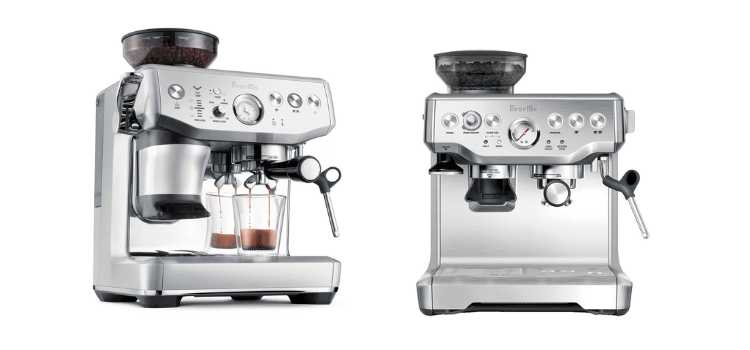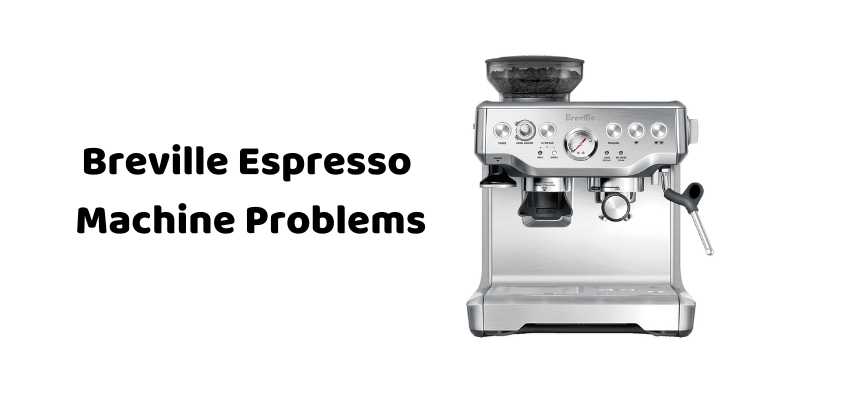As an Amazon Associate, I earn from qualifying purchases

Breville has established itself as a household name in the world of coffee enthusiasts, known for producing high-quality, user-friendly espresso machines that bring café-level coffee experiences into your home. As with any sophisticated appliance, however, Breville espresso machines are not without their occasional hiccups.
Understanding these common issues not only enhances your coffee-making experience but also extends the longevity of your machine. This article aims to illuminate some of these frequent problems and provide practical solutions to keep your morning routine smooth and caffeinated.
Common Problems with Breville Espresso Machines
Water Leakage
One of the more prevalent issues with Breville espresso machines is water leakage, which can be both frustrating and messy. If you notice water pooling around the base of your machine, it’s a clear sign that something isn’t quite right. The culprit could range from loose components, such as the water tank not being properly seated, to more severe issues like a faulty seal or gasket.
Start by ensuring that all removable components, especially the water tank and drip tray, are securely in place. Check for any visible cracks or wear in the seals, which might require replacement. Regularly cleaning and drying these parts can also prevent future leaks by ensuring no residue builds up, which can interfere with seals.
Inconsistent Coffee Quality
Achieving that perfect cup of espresso can sometimes feel like chasing a moving target. Inconsistent coffee quality is often linked to variables such as grind size, tamping pressure, and water temperature. If your espresso tastes too bitter or too weak, it might be time to fine-tune your process.
Start by examining your grind size. Espresso requires a fine grind, but not so fine that it clogs the portafilter. Experiment with different settings if your grinder allows it. Tamping pressure is another crucial factor; aim for firm, even pressure. Finally, ensure your machine is preheated to the correct temperature, as this affects extraction quality. Using fresh coffee beans and regularly calibrating your machine also significantly contributes to consistency.
Machine Not Turning On
Few things are more disappointing than waking up to find your espresso machine won’t power on. Most often, this issue comes down to electrical problems or simple user errors. Begin by checking that your machine is properly plugged in and that the outlet is functioning. If the machine still won’t turn on, inspect the power cord for any visible damage.
Breville machines often come with a reset function that can resolve minor glitches. Refer to the user manual to find the reset instructions specific to your model. If the machine remains unresponsive, it might be time to contact a professional for repairs, especially if it’s within the warranty period.
Maintenance Tips for Breville Espresso Machines

Maintaining your Breville espresso machine is key to preventing problems and ensuring it functions efficiently for years to come. Establishing a regular cleaning routine can prevent build-up and mechanical issues. After each use, clean the portafilter and group head to remove any coffee residue that might affect future extractions.
Descaling your machine, which involves removing mineral build-up from the internal components, is crucial, especially if you live in an area with hard water. Follow the manufacturer’s recommendations for descaling frequency and use a recommended descaling solution or a mixture of vinegar and water.
Periodically, inspect the machine’s components for wear and tear. The seals, gaskets, and filters wear out over time and may need replacement. Keeping an eye on these parts and replacing them when necessary can prevent more severe issues down the road.
Troubleshooting Advice
When issues arise, a methodical approach to troubleshooting can often resolve them without the need for professional intervention. Begin with simple steps such as consulting the Breville user manual, which often contains a wealth of troubleshooting tips specific to your model.
Online resources, including forums and video tutorials, can also be incredibly helpful. Many coffee enthusiasts share their experiences and solutions to common problems, providing a community-driven support system. If your initial attempts don’t resolve the issue, these resources might offer alternative solutions.
When to Seek Professional Help
While many problems can be resolved at home, some situations require professional expertise. If you notice persistent issues that affect the machine’s performance or if the machine has visible damage, it’s time to seek professional help. Breville offers warranty services, so be sure to check if your machine is still covered.
Selecting a reliable repair service is crucial. Look for services that specialize in Breville products or have strong reputations for handling espresso machines. A professional can accurately diagnose and resolve issues that might be beyond DIY fixes.
Conclusion
Breville espresso machines are designed to deliver quality coffee experiences, but like any complex appliance, they require care and attention to detail. By understanding common problems such as water leakage, inconsistent coffee quality, and electrical issues, you can address these challenges effectively.
Regular maintenance and a good troubleshooting routine can keep your machine running smoothly, ensuring you enjoy your favorite brews day after day. Remember, timely intervention with minor issues can prevent major repairs, and when in doubt, professional help is always a wise choice. With these strategies in hand, your Breville espresso machine can continue to be a reliable partner in your coffee journey.
FAQ
Why is my Breville espresso machine not working?
Your Breville espresso machine might not work due to power issues, such as a faulty outlet or a damaged power cord. Ensure it’s properly plugged in and the outlet functions. Check for a tripped breaker. If unresolved, consult the user manual or consider professional repair for internal malfunctions.
Why is my espresso machine not working?
If your espresso machine isn’t working, check the power source and ensure it’s plugged in correctly. Inspect the water reservoir and ensure it’s filled and properly aligned. Cleaning clogged filters or descaling might solve the issue. Persistent problems may require consulting the manual or professional assistance.
Why is no coffee coming out of my Breville?
If no coffee comes out, ensure the water reservoir is filled and properly seated. Check the grind size; overly fine grinds can block the filter. Clean the portafilter and group head to remove clogs. If issues persist, descale the machine to remove mineral build-up.
Why is my Breville espresso machine not grinding properly?
Improper grinding can result from dull burrs or incorrect grind settings. Ensure beans are dry and fresh, as oily beans can clog the machine. Adjust the grind size for your desired consistency. Regular cleaning of the grinder is essential to maintain performance. If problems continue, consult a specialist.
As an Amazon Associate, I earn from qualifying purchases